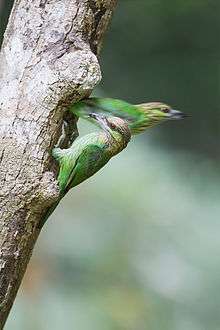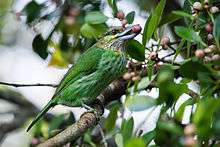Green-eared barbet
The green-eared barbet (Psilopogon faiostrictus) is an Asian barbet.
| Green-eared barbet | |
|---|---|
 | |
| Scientific classification | |
| Kingdom: | Animalia |
| Phylum: | Chordata |
| Class: | Aves |
| Order: | Piciformes |
| Family: | Megalaimidae |
| Genus: | Psilopogon |
| Species: | P. faiostrictus |
| Binomial name | |
| Psilopogon faiostrictus (Temminck, 1831) | |
| Synonyms | |
|
Megalaima faiostricta | |
Characteristics

The green-eared barbet is 24.5–27 cm in length. It is a plump bird, with a short neck, large head and short tail. The adult has a white-streaked brown head and breast, green ear coverts, mainly dark bill, and green-streaked yellow belly. The rest of the plumage is green. Both sexes and immature birds are similar. This species resembles lineated barbet, but is smaller, has the distinctive green ear patch, a darker bill and a dark, rather than yellow, eye-ring.
Distribution and habitat

The green-eared barbet is a resident breeder in southern China, Cambodia, Laos, Thailand and Vietnam. It inhabits broadleaf evergreen and mixed or open woodlands at up to 900 m (3,000 ft) elevation.
Behaviour and ecology
It nests in a tree hole. The male's territorial call is a loud took-a-prruk. Another call is a mellow pooouk.
References
- BirdLife International (2012). "Psilopogon faiostrictus". IUCN Red List of Threatened Species. 2012. Retrieved 26 November 2013.CS1 maint: ref=harv (link)
- Robson, C. (2002). A Field Guide to the Birds of Thailand. London: New Holland. ISBN 9781843300588.
External links
- "Green-eared Barbet Psilopogon faiostrictust". Birdlife International. 2019.
